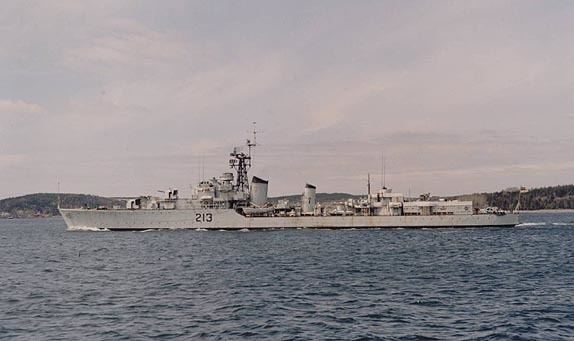Name Nootka Ordered April 1941 Commissioned 9 August 1946 Construction started 20 May 1942 Length 108 m Displacement 1.996 million kg Builder Halifax Shipyard | Laid down 20 May 1942 Decommissioned 6 February 1964 Launched 26 April 1944 Weight 2,235 tons Draft 3.4 m | |
 | ||
HMCS Nootka was a Tribal-class destroyer that served in the Royal Canadian Navy from 1946 to 1964. She saw service in the Korean War. She received the unit name Nootka while still under construction in Halifax after the RCN renamed the Fundy-class minesweeper HMCS Nootka (J35) to HMCS Nanoose (J35) in 1943.
Nootka was ordered in April 1941. She was laid down on 20 May 1942 by Halifax Shipyards at Halifax, Nova Scotia and launched 26 April 1944. She was commissioned into the Royal Canadian Navy on 7 August 1946 at Halifax. She was the sixth Tribal-class destroyer to serve and the second Canadian-built.
Service history
After commissioning, Nootka served as a training ship for the Atlantic Fleet. She was one of the ships assigned to take part in Operation Scuttled, the training exercise designed to sink U-190, the U-boat that had surrendered to the Royal Canadian Navy at the end of the Second World War. However before Nootka and her fellow ships could find the range on the submarine, the aircraft of the Naval Air Arm successfully attacked the vessel and sank her. In September 1948, she joined HMCS Magnificent and HMCS Haida on a training cruise to the Ungava peninsula in Quebec. There the two destroyers left the aircraft carrier and toured the north, visiting Churchill, Manitoba, becoming the first RCN warships to penetrate Hudson Bay. She remained as a training vessel until her conversion to a destroyer escort after being paid off on 15 August 1949.
During the conversion to DDE, her 4.7 inch guns were replaced with 4 inch guns and the Y mounting was removed and 2 triple-barrelled Mark IV Squids were installed. She also received 2 Boffin gun mounts and a single 40mm Bofors on a twin 20mm Oerlikon-powered mounting. She received the new pennant DDE 213 in January 1950 and departed Halifax for Korea in December 1950.
She transited the Panama Canal for the first of two tours of duty in the Korean War. On her first tour, she relieved HMCS Sioux, taking her place as one of the three Canadian destroyers assigned to the region. Not long after arrival, she was sent for shore bombardment duties in the Inchon area in January and was fired upon by Communist guns. On 16 March 1950 she became the Senior Officer's Ship for the Canadian force in the theatre, replacing HMCS Cayuga. During her time in Korean waters she performed blockade, inshore bombardment and carrier screening duties. She sailed for home on 20 July 1950.
Her second tour in Korean waters took place from 12 February 1952 until 9 February 1952. She returned to Halifax via the Mediterranean Sea, having become the second Canadian warship to circumnavigate the globe; HMCS Quebec having been the first.
Nootka underwent further conversion and modernization in 1953-1954 and resumed training duties with the Atlantic Fleet. She participated in the massive RCN deployment for the Cuban Missile Crisis in 1962; Nootka was assigned a patrol area off the northern tip of Cuba during the crisis.
In summer 1963, Nootka joined her sister ship HMCS Haida for a tour of the Great Lakes. Her last deployment was for a NATO exercise in Bermuda in fall 1963 where she sustained hull damage while docking in strong winds. She was temporarily patched and returned to Halifax and was decommissioned at Halifax on 6 February 1964. She was scrapped at Faslane, Scotland in 1965.
